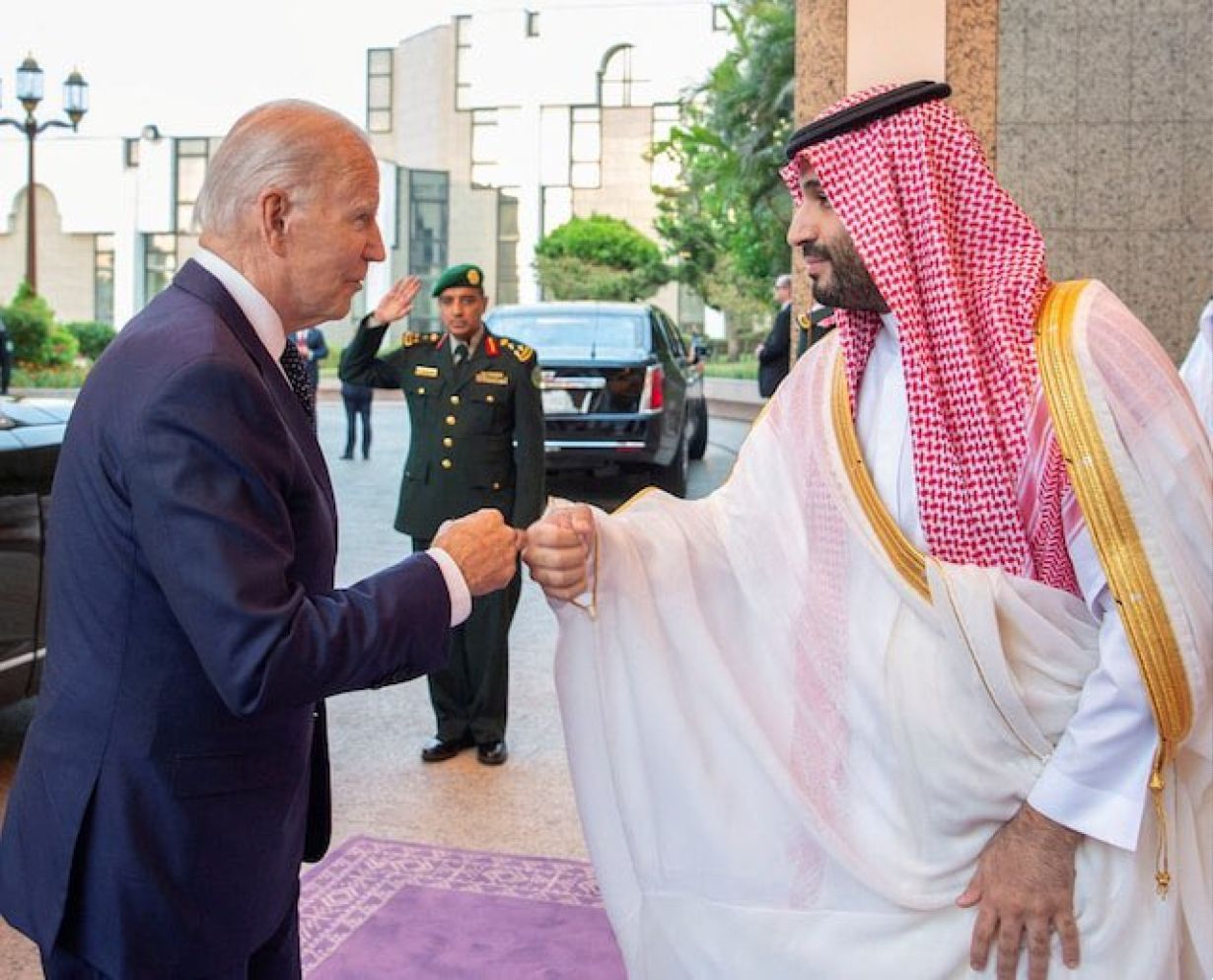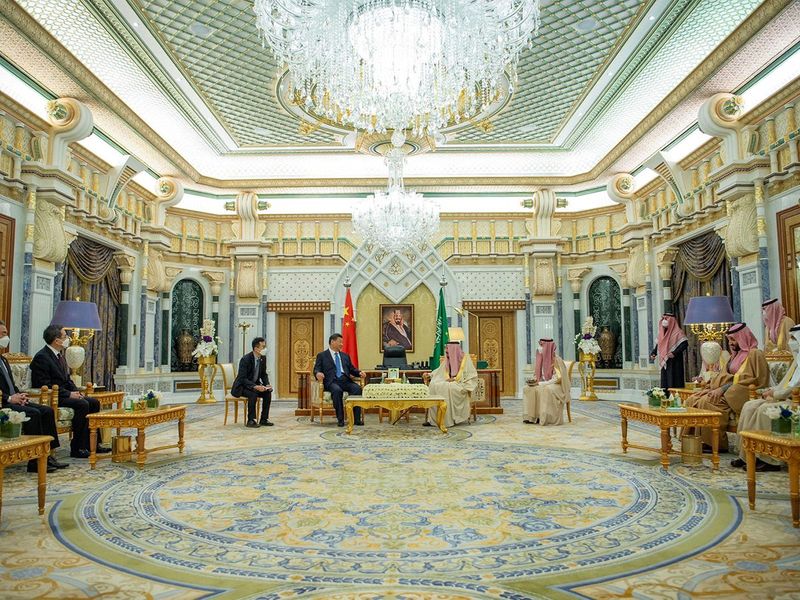After a gap of six long years, Chinese President Xi Jinping arrived in oil-rich Saudi Arabia on December 7 for a much-anticipated summit with the Gulf-Arab world. While several deals are on the agenda for this three-day visit, the grand welcome already set the tone for the grand alliance.
Flying the hawk military aircraft, Saudi Arabian pilots took to the skies and painted it red and yellow, the colors of the communist state’s flag. According to reports, the Chinese President’s aircraft was escorted by the Hawks until it landed.
Chinese President #XiJinping arrived in Riyadh, Saudi Arabia on Wednesday afternoon. Saudi concierge escort planes welcomed the Chinese president with the highest courtesy. #ChinaArab2022 pic.twitter.com/fNYNPdDzxA
— CGTN (@CGTNOfficial) December 8, 2022
On arrival, the President was given a splendid ‘purple carpet’ welcome and was received by the Governor of Riyadh Province, Prince Faisal bin Bandar Al Saud. This is the first visit of Chinese President Xi Jinping since 2016 and comes at a time when Riyadh is looking to diversify its global alliances away from its key ally, the United States.
On December 8, the President arrived at the Al-Yamamah Palace to hold a summit with Saudi King Salman. In what could be a beginning of a new era in ties, the two sides signed a “comprehensive strategic partnership agreement” and discussed joint coordination efforts.
#PHOTOS: #SaudiArabia and #China sign comprehensive strategic partnership agreement during meeting between King Salman and President #XiJinpinghttps://t.co/QOpiFji67B pic.twitter.com/YOgszGxKDd
— Arab News (@arabnews) December 8, 2022
The two heads of state were joined by the Saudi Crown Prince and heir-apparent of the oil-rich kingdom, Mohammad Bin Salman. According to local reports, the two leaders discussed investment opportunities in regional resources and wide-scope development.
It is pertinent to note that China has positioned this visit as “the most important in four decades.”
Earlier, Saudi Arabia’s key partner in the West, the United States, had warned that China’s attempts to expand its global influence were “not conducive” to the international order.
The US National Security Council spokesman said, “We are mindful of the influence that China is trying to grow around the world. The Middle East is certainly one of those regions where they want to deepen their level of influence.”
In what could cause heartburn in the United States, the two sides signed several bilateral agreements, including a deal with China’s Huawei for cloud computing and building GBPS10 complexes in Saudi cities, according to Saudi Press Agency. The United States has banned the telecom giant because of “national security threats” and urged its ally to ban the company from 5G programs.
The Saudi Association with Huawei was also considered a major factor behind the US reluctance to sell the F-35 fighter jets to Riyadh. The fractures within the alliance between the US and Saudi Arabia have been around for a while and peaked over human rights issues, for example, the unequivocal critique of the Saudi plot to kill journalist Jamal Khashoggi.

Despite granting an amnesty to Crown Prince Mohammad Bin Salman, who reportedly masterminded the killing, the issue has refused to abate. It has only exacerbated given the oil-rich nation-led OPEC+ decision to cut oil production – a move that triggered an angry response from the United States as inflation looms large.
Against that backdrop, the Chinese President’s visit to the kingdom could be heralding a new era of geopolitical churning, as was evident in the US’ overt warning.
China-Saudi Bonhomie Could Rattle The US
Besides signing a comprehensive strategic partnership agreement, China and Saudi Arabia signed about 34 new bilateral agreements, including a Memorandum of Understanding (MoU) on hydrogen energy and encouraging direct investment between the two states.
According to local reports, the two sides also signed a landmark agreement to harmonize the Saudi Kingdom’s 2030 vision and China’s ambitious belt and road initiative.
Riyadh’s 2030 vision aims to reduce the dependence on oil, while China’s BRI is a global infrastructure development initiative that aims to connect Asia with Africa.
Saudi Arabia is the world’s largest oil exporter, and China is its top customer. However, there was no information about new energy deals at the time of writing this report.
Earlier, Saudi Energy Minister Prince Abdulaziz bin Salman had said that cooperation with China, the world’s top oil exporter, had helped maintain global oil market stability.
China is widely recognized as Saudi Arabia’s most significant economic trading partner, with military cooperation between the two also constantly on the rise. Saudi Arabia has bought several armed drones from China in recent years. According to reports, these drones were used in Yemen during airstrikes by Saudi Arabia against the Houthi rebels.

It is pertinent to note that Saudi Arabia has been making consistent efforts to wean itself off its military dependence on the United States, partly due to the latter’s hesitation to sell weapons due to human rights concerns. This has created a window of opportunity for Beijing.
China has been making coordinated efforts to expand its reach to the energy-abundant Gulf Arab state. This became evident when it signed a 27-year LNG deal with Qatar last month. More such energy deals with other Gulf Arab countries could be expected as the China-GCC Summit unfolds.
The China-Arab States Summit was referred to as “a milestone in the history of China-Arab countries relations” in an editorial published by China’s state-run tabloid Global Times.
According to the article, the area had a shared objective to avoid political unrest and achieve steady growth following the severe effect of the Arab Spring and was keenly interested in China’s experience.
- Contact the author at sakshi.tiwari9555 (at) gmail.com
- Follow EurAsian Times on Google News




